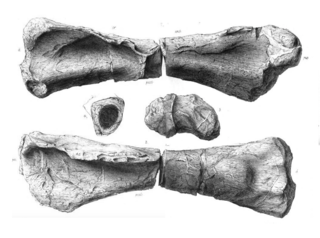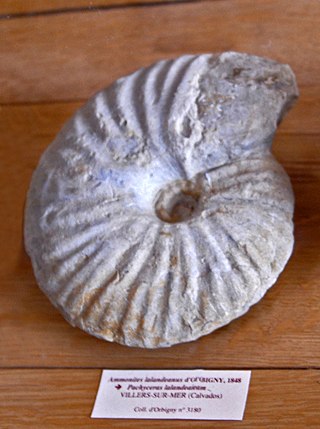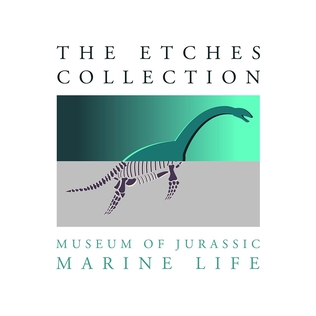Gigantosaurus is a dubious genus of Sauropod dinosaur from the Late Jurassic Kimmeridge Clay Formation of England. The type species, Gigantosaurus megalonyx, was named and described by Harry Govier Seeley in 1869.

The Oxford Clay is a Jurassic marine sedimentary rock formation underlying much of southeast England, from as far west as Dorset and as far north as Yorkshire. The Oxford Clay Formation dates to the Jurassic, specifically, the Callovian and Oxfordian ages, and comprises two main facies. The lower facies comprises the Peterborough Member, a fossiliferous organic-rich mudstone. This facies and its rocks are commonly known as lower Oxford Clay. The upper facies comprises the middle Oxford Clay, the Stewartby Member, and the upper Oxford Clay, the Weymouth Member. The upper facies is a fossil poor assemblage of calcareous mudstones.
In the geologic timescale, the Kimmeridgian is an age in the Late Jurassic Epoch and a stage in the Upper Jurassic Series. It spans the time between 154.8 ±0.8 Ma and 149.2 ±0.7 Ma. The Kimmeridgian follows the Oxfordian and precedes the Tithonian.

The Kimmeridge Clay is a sedimentary deposit of fossiliferous marine clay which is of Late Jurassic to lowermost Cretaceous age and occurs in southern and eastern England and in the North Sea. This rock formation is the major source rock for North Sea oil. The fossil fauna of the Kimmeridge Clay includes turtles, crocodiles, sauropods, plesiosaurs, pliosaurs and ichthyosaurs, as well as a number of invertebrate species.

Kimmerosaurus is an extinct genus of plesiosaur from the family Cryptoclididae. Kimmerosaurus is most closely related to Tatenectes.

Colymbosaurus is a genus of cryptoclidid plesiosaur from the Late Jurassic (Callovian-Tithonian) of the UK and Svalbard, Norway. There are two currently recognized species, C. megadeirus and C. svalbardensis.

Brachypterygius is an extinct genus of platypterygiine ophthalmosaurid ichthyosaur known from the Late Jurassic of England. The type species was originally described and named as Ichthyosaurus extremus by Boulenger in 1904. Brachypterygius was named by Huene in 1922 for the width and shortness of the forepaddle, and the type species is therefore Brachypterygius extremus. The holotype of B. extremus was originally thought to be from the Lias Group of Bath, United Kingdom, but other specimens suggest it more likely came from the Kimmeridgian Kimmeridge Clay of Kimmeridge Bay, Dorset, UK.

Nannopterygius is an extinct genus of ophthalmosaurid ichthyosaur that lived during the Middle Jurassic to the Early Cretaceous. Fossils are known from England, Kazakhstan, Russia, and Norway and six species are currently assigned to the genus.

Bathyspondylus is an extinct genus of plesiosaur from the Kimmeridge Clay Formation of Swindon, England. Because it is known only from its fossil vertebrae, paleontologists are not entirely sure of the taxonomy of Bathyspondylus; the family it belongs to is not currently known. The type, and only known, species is B. swindoniensis, which was described from the same material as its genus.

Duriatitan is a genus of titanosauriform sauropod dinosaur that lived in the Late Jurassic in what is now England. The holotype specimen of Duriatitan, BMNH 44635, is a partial left upper arm bone which was found by R.I. Smith near Sandsfoot, Weymouth in the lower Kimmeridge Clay from Dorset. The type species, D. humerocristatus, was described in 1874 by John Hulke as a species of Cetiosaurus and was noted as being similar to that of Gigantosaurus. The specific name refers to the deltopectoral crest, crista, on the upper arm bone, humerus. The specimen was assigned to its own genus by Paul M. Barrett, Roger B.J. Benson and Paul Upchurch in 2010. The generic name is derived from the Latin name for Dorset, Duria, and Greek Titan. Thomas Holtz estimated its length at 25 meters (82 ft).
Involuticeras is a perisphinctoid ammonite belonging to the Aulacostephanininae from the Upper Jurassic of Europe and possibly Mexico. The shell is involute, moderately compressed, with a rounded and ribbed venter. The genus is similar in general form to Aulacostephanus and Epicephalites.

Juratyrant is a tyrannosauroid dinosaur genus from the late Jurassic period of England. The genus contains a single species, Juratyrant langhami, which was once classed as a species of Stokesosaurus.

Pectinatites is an extinct cephalopod genus belonging to the order Ammonoidea, that lived during the upper Tithonian stage of the Late Jurassic. They were fast-moving nektonic carnivores.
Spitrasaurus is an extinct genus of cryptoclidid plesiosauroid plesiosaur known from the uppermost Jurassic of central Spitsbergen, Norway and likely also Kimmeridge, England. It is named after a syllabic abbreviation for Spitsbergen Travel.

Pachyceras is a genus of perisphinctoid ammonites from the Middle Jurassic, upper Callovian stage, and is the type genus for the family Pachyceratidae. The shell is involute, subglobular, with a deep umbilicus and flattened flanks that slope toward a more narrowly rounded venter, and covered by low, widely spaced ribs.

Cephalopod egg fossils are the fossilized remains of eggs laid by cephalopods. The fossil record of cephalopod eggs is scant since their soft, gelatinous eggs decompose quickly and have little chance to fossilize. Eggs laid by ammonoids are the best known and only a few putative examples of these have been discovered. The best preserved of these were discovered in the Jurassic Kimmeridge Clay of England. Currently no belemnoid egg fossils have ever been discovered although this may be because scientists have not properly searched for them rather than an actual absence from the fossil record.
Saxoceras is a genus of very evolute schlotheimiid ammonoids from the Lower Jurassic.

Steve Etches, MBE is an English plumber, fossil collector and preparator in Kimmeridge, on the Isle of Purbeck in Dorset. From an early age on, Etches began to find, collect and restore the fossils he found on the Jurassic Coast. His collection is now housed in a museum called The Etches Collection which was purpose-built, both to house the collection and to replace the deteriorating local village hall. Etches has won many prizes for his palaeontology and was made a Member of the Order of the British Empire by the Queen in 2014. In 2017, he was also awarded an Honorary Doctorate by the University of Southampton. On 22 April 2019, he appeared on the natural history podcast Trees A Crowd with David Oakes.

The Etches Collection is an independent fossil museum located in the village of Kimmeridge, Dorset, England. It is based on the lifetime collection of Steve Etches, a fossil hunter for whom some of his finds have been named, from the local area on the Jurassic Coast, a SSSI and World Heritage Site, especially around Kimmeridge Bay and the Kimmeridge Ledges.

Thalassodraco is an extinct genus of ophthalmosaurid ichthyosaur from the Late Jurassic (Tithonian) Kimmeridge Clay Formation of England. The type species, T. etchesi, was named in 2020, with the epithet in honour of the discoverer of the holotype, Steve Etches.















